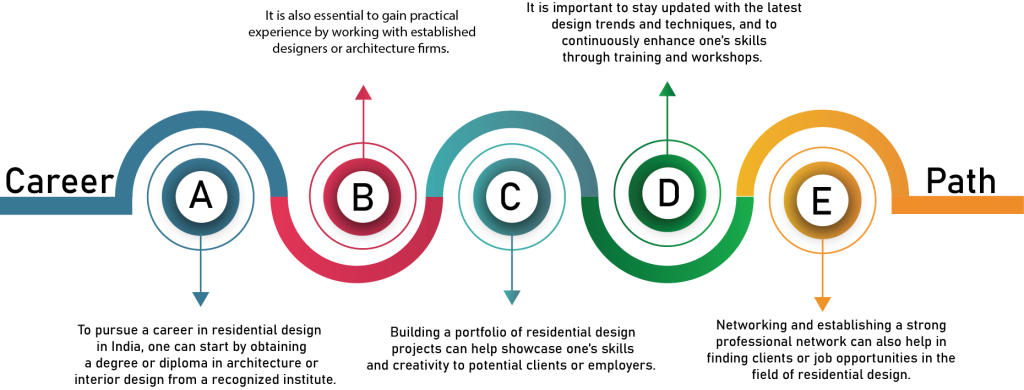A career in residential design involves creating functional and aesthetically pleasing spaces for people to live in. Residential designers work closely with clients to understand their needs and preferences, and then use their creativity and technical skills to design homes that meet those requirements. This may involve selecting materials, designing layouts, choosing colors and finishes, and creating 3D models or renderings. Successful residential designers have strong communication and collaboration skills, as well as a keen eye for detail and a passion for design. They may work for architecture firms, interior design companies, or as freelance designers.
Work description
The work of a residential designer typically involves
- meeting with clients to assess their needs and preferences
- creating design plans and layouts
- selecting materials and finishes
- overseeing construction and installation
- managing budgets and timelines.
High Demand
Creative and fulfilling work that allows you to express your artistic side.
Lucrative salaries
Opportunity to make a significant impact on the living spaces of your clients.
Opportunities for innovation
High demand for skilled residential designers, as homeowners are always seeking to improve their living spaces.
Versatility
Ability to work independently or with a team, depending on your preference.
Flexibility
Flexibility in terms of work hours and location, as many designers work on a project-by-project basis.
Job satisfaction
The potential for high earnings, depending on your level of experience and success.
High stress
Competitive industry, as many designers are vying for the same clients.
Long hours
Long and irregular work hours, especially when working on tight deadlines.
Competitive field
Can be emotionally taxing, as you may encounter clients who are difficult to work with or who have unrealistic expectations.
Constant learning
Requires a significant amount of self-promotion and marketing to build a client base and maintain steady work.
Isolation
Must stay up-to-date with the latest design trends and technologies, which requires ongoing education and training
India has a growing demand for residential design professionals due to the country’s rapid urbanization and increasing affluence of the middle class. While the investment required to pursue a career in residential design in India can vary, it typically involves obtaining a degree or diploma in interior design or architecture, which can be costly.
However, the earning potential in residential design in India can be quite lucrative. Experienced and skilled professionals in this field can command high salaries and enjoy opportunities for growth and advancement. Additionally, the Indian government’s initiatives to promote affordable housing and sustainable design have opened up new avenues for residential design professionals.
Creativity and imagination to come up with unique and functional design solutions
Attention to detail to ensure accuracy and precision in drawings and specifications
Ability to communicate effectively with clients and contractors to ensure client satisfaction
Knowledge of building codes, materials, and construction techniques
Ability to work independently and manage multiple projects simultaneously
Difficulty working with clients who have different design preferences or tastes
Limited job opportunities in certain regions or during economic downturns
Physical demands of spending long hours at a desk or computer, and potentially traveling to job sites
Pressure to meet strict deadlines and work within budget constraints
Exposure to liability if designs are not structurally sound or do not meet building codes.
Work-life balance
The work-life balance of a residential designer can vary widely depending on their workload and project schedule. While some designers may have a more flexible schedule that allows for a better work-life balance, others may work long and irregular hours to meet project deadlines.
Additionally, designers who own their own firms or work as freelancers may experience more stress and have a harder time achieving a good work-life balance, as they are responsible for managing their own business and finding new clients.

Residential designers have the potential to make a significant impact on the lives of their clients by creating beautiful, functional living spaces that improve their quality of life.
Additionally, designers who focus on sustainable design practices can have a positive.
impact on the environment by promoting energy-efficient and eco-friendly design solutions.
Architectural Design
Architectural designers work on the overall design of a residential building, including its exterior appearance, floor plans, and building materials.
Landscape Design
Landscape designers work on the design of the outdoor spaces of a residential building, including gardens, patios, and outdoor entertainment areas.
Lighting Design
Lighting designers focus on the placement and design of lighting fixtures throughout a residential building, creating ambiance and highlighting architectural features.
Sustainable Design
Sustainable designers work on creating residential buildings that are environmentally responsible, energy-efficient, and sustainable in the long run.
Universal Design
Universal designers create residential buildings that are accessible and functional for people of all ages and abilities, including those with disabilities.
Conclusion:
In Conclusion, pursuing a Career in Computer Engineering in India requires a Strong Foundation in math and science, a passion for technology, and a willingness to continuously learn and adapt to New Developments in the industry. With competitive salaries, opportunities for career growth, and the potential to make a significant impact on society, computer engineering can be a Rewarding and Fulfilling Career choice for those who are up for the challenge.




